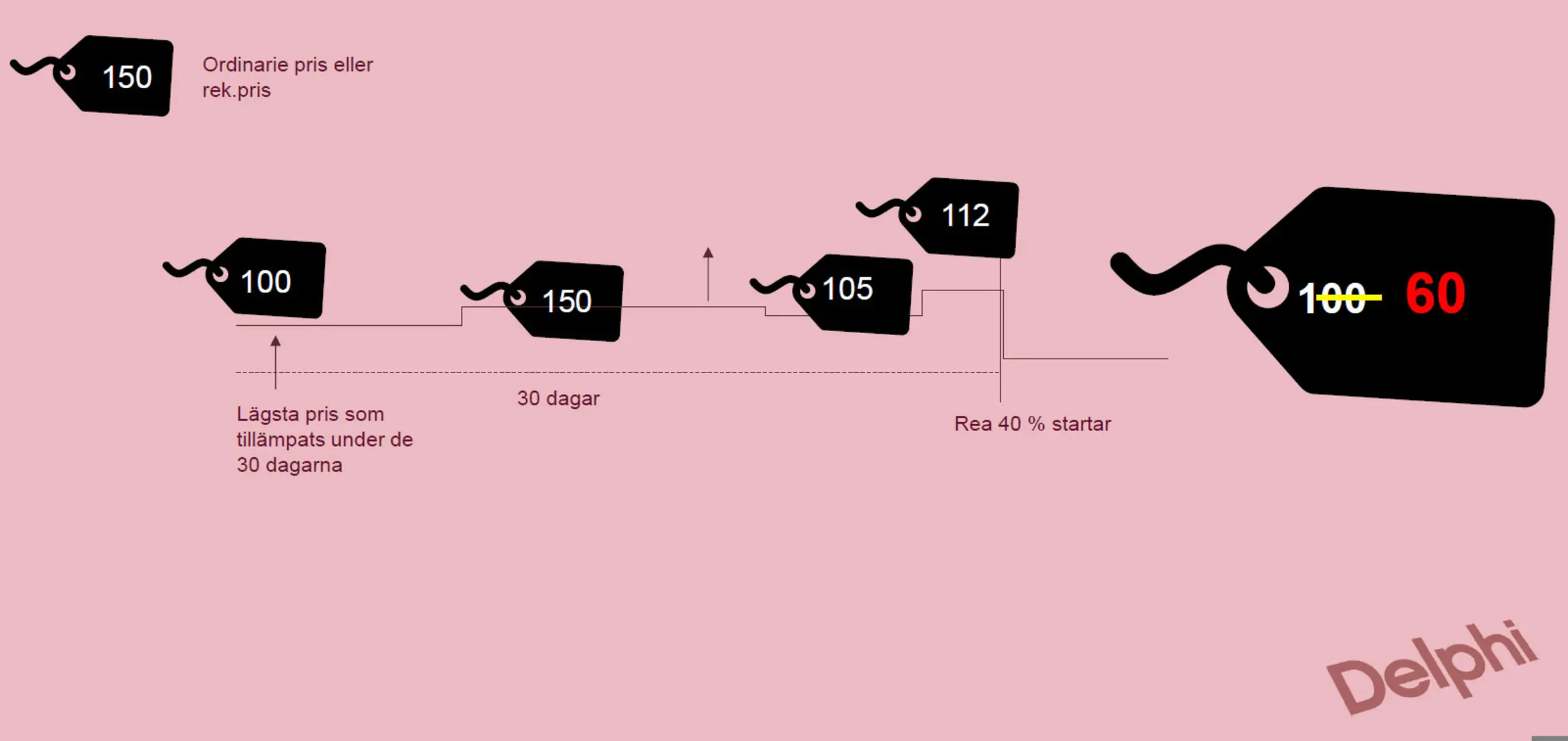Agnes Hammarstrand from the law firm Delphi invited to a popular webinar where they went through both which laws to take into account in Sweden and how to think about pricing when it is now time for the holiday of retail. In 2022 when the new rules on price information came into force, we wrote a summary that many have taken note of and that may be worth reading again.
Overview and supervision by the Swedish Consumer Agency
The Price Information Act contains, among other things, general rules on how prices may be stated and also the rule in the event of price reductions where the previously applied price must be clearly displayed, the 30-day rule.
The Swedish Consumer Agency inspected around a hundred companies in 2023 and initiated supervision of 70 of them. They found shortcomings according to both the Price Information Act and the Marketing Act. In some cases, this led to a ban with a fine. In 2024, a new inspection was carried out where it was found that 4 out of 10 e-commerce companies were violating the 30-day rule. In the spring of 2025, 10 companies were ordered to remedy the errors with the threat of a fine of between 1-3 million SEK. The companies that the Swedish Consumer Agency has inspected where there are shortcomings will be followed up carefully to ensure that they comply with the laws in the future.
The Marketing Act contains, among other things, rules on how sales and sales may be used and a ban on misleading marketing, this includes price. It also regulates that price comparisons must be fair and accurate.
- Proof – If you claim something, it must be possible to prove it in every way imaginable. If you write that you are the cheapest, you must also be able to prove it.
- Misleading – It is forbidden to state misleading prices. Keep this in mind when calculating prices and when specifying payment terms, for example. State the total final price.
The sale rule
The sale rule is a special rule about sales in the Marketing Act. It looks a little different in different EU countries. It applies to concepts such as sale, realization or expressions with a similar meaning. You can use this if the products are included in the regular range, for a limited time and the prices are to be significantly lower. A good example is Black Friday or mid-day sales during Christmas.
Separate sales and other offers and campaigns. Product of the week and similar, spring campaign, special price are not subject to the same strict requirements, but it can be misleading, so it is important to be careful. Keep in mind that you may not give the impression on the entire site that it is a campaign that could resemble a sale. Several of the cases that the Swedish Consumer Agency handles concern cases where other offers have been interpreted as a sale from the Swedish Consumer Agency.
The Price Information Act with the 30-day price rule
The Price Information Act only applies to sales to consumers. The act applies to a purchase offer that is a price statement for a specific product. The purpose is for consumers to be able to compare offers and make an assessment based on the offer. There are several requirements for information in a purchase offer. The Price Information Act is very much common sense, that it should be clear, conspicuous and clearly visible.
30-day price is based on EU directives that are intended to protect consumers against misleading price reductions. A typical example is those who raise the price just before a campaign and then lower it and give the impression that the discount is greater, but where the product may have been sold cheaper in the past month.

When you choose to flash to show that you are lowering the price, you must specify the previous price. For example, by specifying sale, reduced price, crossed out prices, 20%, 50% discount and the like. Only then must you specify the previous lowest price.
- This does not apply if you use dynamic pricing where you do not specify the previous price.
- Nor if you use general statements such as low prices, always a good offer.
- You also do not need to use it for goods with a short shelf life such as plants and fresh food.
- It is also not necessary for gradual price reductions without interruption, when you successively reduce prices during a campaign. If a product is first 30% and then immediately 50%, you can still compare it with the same price as when the reduction began.
- More exceptional cases are discounts for customer clubs and points systems and also when they are linked to the consumer's previous purchases or individual occasions such as birthday offers.
Recommended prices and approximate prices
Approximate price and recommended price must have been recommended in the past by, for example, manufacturers or distributors and have been used to some extent on the market. It must be consistent with reality. Take screenshots, save the information that the price has actually been applied on the market in case you are subject to an inspection later. This is an important part, you must be able to prove what you claim.
If you compare prices with others, it must relate to the same need or purpose, not be misleading and you must not discredit a competitor.
Typically, the Swedish Consumer Agency does not want to see any other prices in a comparison besides the 30-day price. That price should be stated in close proximity to the discounted price with a style and size that makes it easy to read.
It is important to be extremely clear with the layout if you also want to show the regular or recommended price. Previously, the Swedish Consumer Agency was of the opinion that it was not allowed to have three prices. It is now allowed, but they believe that you must be careful if you are going to include an additional price. There is a risk that it will be misleading, so be careful how you present it in such cases.
Summary tips
- Set a well-thought-out strategy for how you work with prices.
- If you don't let the products rest for at least 30 days before Black Friday, you need to specify the previous promotional price that was the lowest in the last 30 days as the comparison price. After this comes Cyber Monday and the Christmas sale, what promotions should you have then and how should those prices be marketed?
- A common mistake made is how the percentage sale is set, it must be done on the lowest price in the last 30 days, not any other price.
- You must be able to prove what you claim. Save evidence, take screenshots, show how competitors do it.
- Don't have sales and similar promotions too often or for too long.
- Be careful when comparing yourself to competitors.
- Don't mislead consumers in any way.
- Educate yourself and stay up to date on what is applicable.
- Set guidelines for how you should act and take into account the law in campaign management.
- Ensure that the technology you use does what it should when automatically comparing with the 30-day price.
- Recommended prices may be stated further down and in smaller text, far away so that the eye does not immediately catch it. However, the Swedish Consumer Agency is hesitant about regular and recommended prices, so if you do not want to risk an inspection, you should think again whether you really want to state these prices at all.
Finally, the law firm Delphi talks about different risk-taking, there are black zones, gray zones and white zones. Outlet is a form of gray zone, usually the 30-day price needs to be stated. Sometimes you may choose to take a risk, but an assessment must be made. Check if you feel hesitant and feel free to do a legal review of the site and your procedures.

